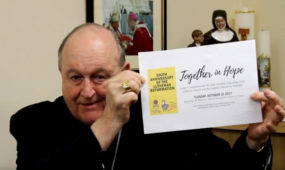Help us to 'see'
Video
In this month's podcast, Archbishop Philip Wilson discussed the Plenary Council 2020 and compares the Catholic Church in Australia to the blind man Bartimaeus who asks Jesus to give him his sight and then follows him as his disciple.
The Plenary Council being held by the Catholic Church in Australia in 2020 has been a long time coming.
You would have heard about it during the Year of Grace in 2012 when we spent a year praying to the Lord, asking Him to guide us in reforming the Church and helping us to move forward so that we will be really wonderful witnesses to Jesus.
The decision of the bishops to hold the Plenary Council has come about as a result of that work, so already the power of the Holy Spirit is in action amongst us.
Advertisement
There are three points I would like to make about the Plenary Council. Firstly, when we ask ourselves where the Australian Catholic Church is today, the Scriptures help us to understand our situation. In the Gospel there is a story about a blind man called Bartimaeus who was lying on the side of the road and as Jesus walked by, he asked him to give him his sight. What’s interesting about this is that Bartimaeus is the only person in the Gospel cured by Jesus who immediately began to follow him as his disciple.
The Catholic Church in Australia is like Bartimaeus; we are on the side of the road, Jesus is going past, we are calling out to Jesus in our prayers and in our actions to discover what it is he wants us to see and to help us to do what we need to do to be his best disciples today.
The Plenary Council is an opportunity for the bishops to lead and to carry out the responsibility they have as the shepherds of the Church but they are asked to do that in conjunction with all the people who belong to our faith.
Any process towards a plenary council that is an action of the bishops must be something that is done in consultation, and with the engagement of, all our people. I know this is right at the heart of all the people and processes that are going on now as we clear the decks and get ready for the Plenary Council.
The other two points I’d like to make come from two popes. The first is Pope John Paul II who in his apostolic letter Novo Millennio Ineunte at the end of the great Jubilee Year 2000 suggested that every Church throughout the world should have a major program of looking at itself, reflecting on its relationship with the Lord and asking Him to help it decide what it needed to do to evangelise and spread the Gospel.
That’s what this Council is about. We are taking up the challenge and the guidance that Pope John Paul II gave us.
We are looking to prepare a pastoral plan for our Church in Australia, where we will be able to harness all of the wonderful energies that the Lord has given us and all of the elements that are to be found in the lives of the faithful in Australia and putting them together in a new way to be able to witness to the Lord in a dynamic way for all people.
Advertisement
The second is the influence of Pope Francis. Since he became Pope we have spent a lot of time talking about what kind of Church we need to be today in order to be faithful witnesses to the Lord.
As we prepare for the Council and go through its life, we need to reflect upon the guidance given to us by Pope Francis about what kind of Church is needed today, the values that he talks about in Evangelii Gaudium. These are the values we need to take into account.
So Pope John Paul II and Pope Francis combined give us some really good information and guidance about what we need to do as we gather for this Council in 2020. It is an exciting moment for us: Jesus is passing by and we the Church in Australia call from the side of the road ‘Lord Jesus give us sight, guide us, help us to be the people you want us to be in Australia’.
It’s exciting, it’s full of hope and it’s a great challenge for us today.







Comments
Show comments Hide comments